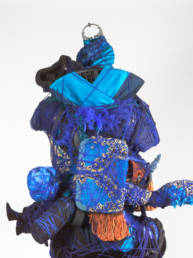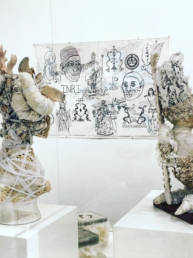Confederate Statue, Plantation Prison: Artists Reclaim Sites with 'Battlegrounds'
Date: 10/30/2019Source: The Los Angeles TimesBy: Deborah Vankin
(Excerpt)
There’s an 800-year-old oak tree in New Orleans City Park, a great big, craggy and handsome planting. It’s named for the late John McDonough, a philanthropist who was also a slave owner and white supremacist.
On Saturday another tree — a hand-drawn, life-sized replica of the McDonough tree — materialized in front of it, completely obscuring the commemorative oak. The work, “Toxic Ecology” by New Orleans artist Hannah Chalew, is invisible to the naked eye, visible only through a free phone app called 4th Wall and pasted into the landscape via augmented reality technology. When viewers point their phones toward the tree, the artwork appears onscreen along with the real surrounding landscape.
“I live close by and am fascinated by this centuries-old tree that we’re literally propping up with big wooden beams,” Chalew said of the draping oak, with its gnarled roots clawing at the ground. “In my drawing, I’m imagining how the legacy of white supremacy still takes root in our landscape. It upholds and makes possible the petrochemical age — the new face of racism and capitalism — exploiting our landscape and people.”
The work is part of the New Orleans AR public art exhibition “Battlegrounds,” conceived of and curated by Los Angeles artist Nancy Baker Cahill, who created 4th Wall. Baker Cahill invited 24 New Orleans artists to choose a location that they felt was contested, a battleground of sorts. A sugarcane plantation, gentrified neighborhoods, prisons, polluted waterways and confederate statues are all represented in the exhibition. She then asked artists to pair one of their artworks — drawing, painting, sculpture, video art and photography — with their chosen site to “activate, illuminate or further augment its meaning or history.”
The 30 AR works in the exhibition have been geolocated and “placed” on-site, some with sound elements. Visitors can follow treasure map-like directions on the app to find them: “Go to: Congo Square … find the biggest tree …” one artist instructs. An online gallery of the works with artists’ statements is on the 4th Wall website so anyone, anywhere, can click through the exhibition.
Destructive forces connect the elements in Kristin Meyers’ “Cyclone,” in which a sculpture made from the invasive cat’s claw vine whirls in the air over a Civil War cannon at Washington Artillery Park.
Jan Gilbert’s “Call to DisArm: Yearbook, 2011-19, Snow Job Sound by Metronome the City” pairs a collage of gun violence victims’ obituaries with the Murder Board memorial at St. Anna’s Episcopal Church in New Orleans. Keith Calhoun’s “Sunlit Nightmare” addresses gentrification. The work features a photograph of a home’s decimated foundation after Hurricane Katrina,backed by an apocalyptic-looking, burnt orange sky, obscuring the new home that’s been built in its place.
Click Here to read the full article at its source.


